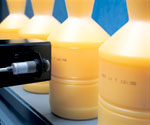
Ink jet coders have long proven their value as workhorse units at food and beverage plants globally.
Photo courtesy Matthews Marking Products
Photo courtesy Matthews Marking Products
Although the political debates for last year’s elections are history, there’s an ongoing debate that packagers face for their marking and coding needs: Ink jet or laser?
According to the experts, the choice begins with asking questions starting with the substrate (see “Coding considerations: Questions to ask” on page 35): the material or surface that is to be coded. From glass to metal to paperboard to plastic-rigid and flexible-and more, the food and beverage market encompasses a wide range of materials.
Scott Begnini, director of continuous ink jet (CIJ) marketing and after-market sales for Videojet Technologies, feels that ink jet coding’s breadth of applications is one of its biggest advantages. “Ink jet coding provides the flexibility to print on anything,” says Begnini. “This allows food and beverage customers to use a single product to print onto their [different] packaging materials.”
The primary type of laser commonly used in food and beverage applications-a carbon dioxide laser-is not appropriate for all materials, such as an unprinted metal surface. And the ability to laser-etch glass may require slower line speeds or a higher power (wattage) laser than a typical 10-watt unit, experts say.
In truth, the assessment of marking quality can be more nuanced. Marketing manager Stephanie Kaminksi of Matthews Marking Products, which supplies both laser and ink jet systems, says “Laser and ink jet systems can mark onto virtually all of the same surfaces, but the difference is more a matter of contrast, readability, and permanence.”
Yet, there are situations that are more challenging even for ink jet codes. Diagraph product manager Jacki Goodall admits, “[Ink jet] marking in the presence of condensation can be tricky.” Because CIJ systems recycle inks, some dusty environments may present maintenance concerns, she adds.
For glass and metal and similarly challenging or high-speed applications, some laser vendors offer higher power models. Industrial Dynamics/filtec’s base model, the Lastec 2, is a 30-watt unit, which permits it to handle most situations for food and beverage packagers including marking onto PET bottles at rates around 1,200 bpm. Laser units are also available up to 50- or 60-watt models. Matthews also offers a more powerful fiber optic laser for packaging applications.
Ink jet systems come in different flavors, too, including drop-on-demand (DOD) units that may be more appropriate for dusty environments or text areas of ¼-inch high or more, according to Kaminski of Matthews, which offers both kinds.
Then there’s the other crucial role within an ink jet system: that of the ink. Lynn Deiro, senior sales manager for ink jet systems supplier Hitachi America, says, “The thing that you have to worry about with ink jet is to match your ink to the substrate.” Hitachi offers more than 30 inks.
These include specialized inks, such as thermochromic, that turn color so that, for example, a red to blue change confirms that the can has been retorted. Another specialty ink fluoresces in the presence of ultraviolet light to reveal otherwise invisible markings.
Thus, inks can add unique value to a coded mark.
Laser, on the other hand, makes its mark by subtraction: A portion of the surface material is removed through either burning, etching, or ablating (removing) it, according to Diagraph’s Goodall.
Another aspect to consider is that of permanence, or how lasting the code should be. It’s an area where laser seems to have an advantage.
However, sometimes permanence is undesirable. Videojet’s Begnini sees a trend in reusable containers where the old code needs to be removed and replaced by a “fresh” code for the new version. That’s a market suited to ink codes.
Cost of ownership
Another major consideration is the cost of ownership: The true cost to operate and maintain a system over time. According to Diagraph, three main areas to consider include the purchase price, maintenance and production downtime costs, and consumables and parts costs.Most experts agree that ink jet coders offer a lower-cost entry point than laser systems.
However, the difference in cost of ownership over time is not as clear cut, and seems to tilt in favor of laser systems due to their lack of consumables.
Matthews’ marketing manager Trace Bocan offers this summary: “For high-volume marking, laser becomes a better value over time, and if lower volume, then ink jet is a better value. As the pricing of laser technology continues to decrease, then laser becomes a more attractive option for higher-volume production lines.”
Laser versus ink jet coding is a debate that will continue in food and beverage plants. Savvy end users should consider all options, armed with the most accurate information available to ensure that your next marking and coding system will be on the mark for years to come.
Coding considerations: Questions to ask
• What is the substrate?
• What production rate is needed?
• What is the operating environment-dusty, humid, etc.?
• What is the importance of flexibility now and for the future?
• How important is readability?
• How important is permanence?
• How frequent are changeovers?
• Are packages of differing substrates run?
• How are the units going to fit into production?
• Will the equipment be moved between production lines?
• What data will be coded: alphanumeric only? How many lines and what size of characters?
• How much capital is available?
For more information
Diagraph
636-300-2000;www.diagraph.com
Matthews Marking Products
412-665-2500;www.matthewsmarking.com
Hitachi America Ltd., Industrial Products Div.
914-631-0600;www.hitachi-america.us/ijp
Industrial Dynamics/filtec
888-434-5852;www.filtec.com
